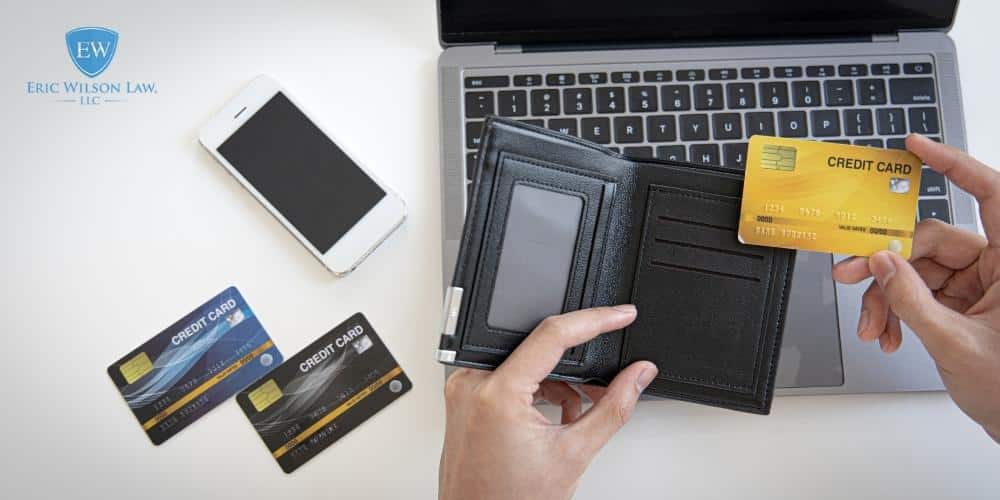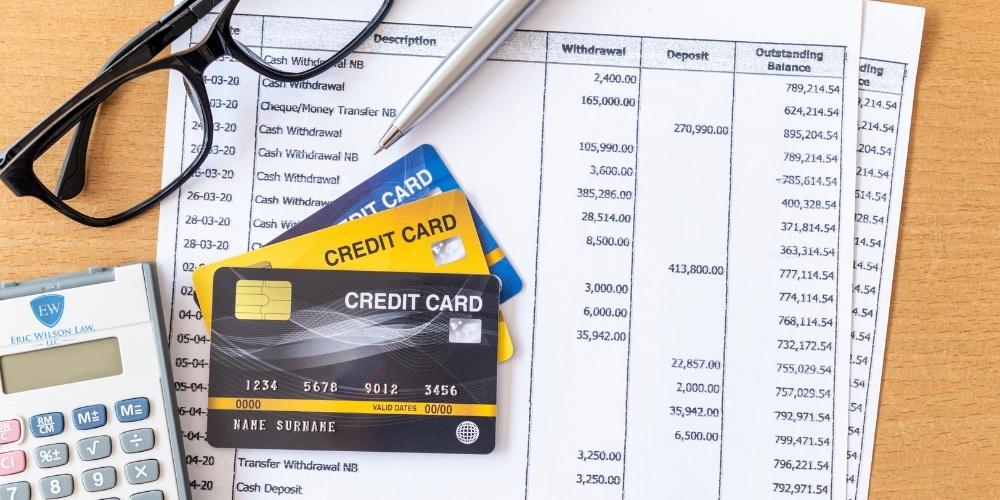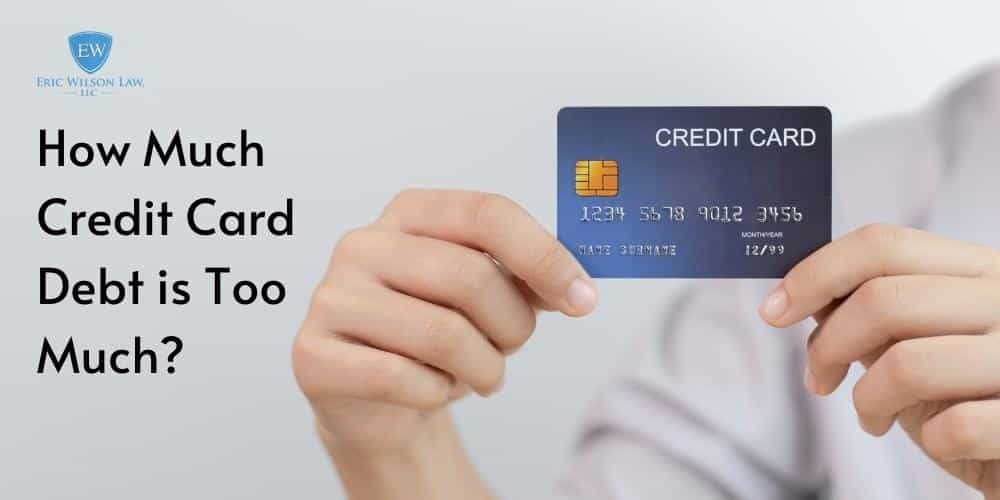Credit cards are the most common example of revolving debt. As a child or teen, credit cards seem like a source of free money with absolutely no strings attached. This can’t be further from the truth. If you’re constantly living outside your means and charging your card, you’ll very quickly find yourself in a dire financial situation. If you’re struggling to make ends meet due to your debt, you may find yourself wondering: how much credit card debt is too much? Below, the team at Eric Wilson Law answers this question and more.
If you feel like you’re constantly struggling to keep up with your credit card balances, you’re definitely not the only one. The average American household has thousands of credit card debt. So while being in debt is pretty normal, it’s certainly not ideal. The good news is that Eric Wilson can get you out of debt and into a life of financial stability. Call 205-349-1280 to schedule a free consultation today.
How Many Americans Have Credit Card Debt?
If you have credit card debt, you’re certainly not alone. Most Americans have some amount of credit card debt. In fact, U.S. credit card debt totaled $841 billion during the first three months of 2022. The average American cardholder had approximately $5,700 of credit card debt during those months.
Americans under the age of 35 have the least credit card debt on average – around $3,700. Meanwhile, Americans over the age of 75 have the most credit card debt compared to any other age group – approximately $8,000 on average.
How to Know if You Have Too Much Credit Card Debt
Maybe your current financial state isn’t looking so good, and you’re wondering: how much credit card debt is too much?
It can be difficult to recognize how bad your financial situation is when you’re in the middle of it. Below, we list some signs that you might have way too much debt.
High Credit Utilization Ratio
In order to determine your credit utilization ratio, you need to divide your total balance by your total credit limit. Lastly, multiply that number by 100 to get a percentage. The result is your credit utilization ratio.
Having a high credit utilization ratio basically means that you’re using too much of your available credit. Ideally, credit card lenders want borrowers to have a credit utilization ratio under 30%. So:
- If your credit limit is $1,000, shoot for less than $300 of debt.
- If your credit limit is $2,000, shoot for less than $600 of debt.
- If your credit limit is $3,000, shoot for less than $900 of debt.
- If your credit limit is $5,000, shoot for less than $1,500 of debt.
And so on.
Obviously, having a lower credit utilization ratio can indicate that your credit card balances are under control. A credit card issuer will think of you as more financially responsible. But your credit utilization ratio is one of the biggest things that can make or break your credit score, next to payment history of course.
High Debt to Income Ratio
In order to determine your debt to income ratio, divide your total monthly debt payments by your total gross monthly income.
Your goal should be to keep your debt to income (DTI) ratio under 35%. But if it’s higher than 43%, then you definitely have too much debt, and you’re probably struggling to make minimum payments on your bills.
It’s crucial to keep your DTI under 43% because that’s the highest ratio that you can have to still qualify for a mortgage loan. Generally though, you will struggle to borrow money for any type of loan once your DTI ratio climbs up into the 40% range.
High Credit Card Debt Ratio
This is basically the same as a DTI ratio but just for your credit cards. In order to determine your credit card ratio, divide your total monthly credit card payments by your total net monthly income.
Generally, it’s best to keep your credit card ratio under 10%. That way, your overall debt to income ratio can stay below 35%.
If you’re throwing a large chunk of your monthly income at your growing credit card balances, then you’re not going to have a whole lot of money left over for everyday purchases and other bills. The interest rate on a credit card is a whole other story. At some point, it’s going to feel like your credit card debt is doubling or tripling every month partially due to your total debt but also due to those interest rates.
Long story short, keeping all of your ratios – credit utilization, DTI, credit card debt – as low as possible is key for survival in this economy.
Making Minimum Payments Every Month
Making minimum payments is a big sign that you have too much debt. It’s true that making a minimum payment will help you avoid late fees. However, making minimum credit card payments doesn’t stop interest from accruing.
Making minimum payments probably means that your income is too low to keep up with your credit card debt every month. At a certain point, the credit card debt that keeps rolling over into the next billing cycle every month is going to turn into a major financial emergency.
Maxing Out Credit Cards
Maxing out multiple credit cards is a big sign that you have too much debt. Not only will maxing out credit cards make your credit utilization ratio skyrocket, but it will also probably lower your credit score. Your minimum debt payments will also probably increase too. All of this is a recipe for disaster. You will naturally struggle to control your credit card bill and you will have far fewer debt relief options due to your lowered credit score.
Using Credit Cards for Cash Advances
A cash advance is a cash withdrawal from your credit card account. This may not sound like a bad idea, but it can lead to major financial consequences. These cash advances come with high interest rates and lots of fees. So even if it helps you with a debt repayment in the short term, you’re still going to have to pay back this cash advance at some point. And if you’re already struggling with high balances on your credit cards, this can take months or even years.
Your Credit Card Debt Payments Are Much Higher Than Your Other Bills
Another sign that you may have way too much credit card debt is if your monthly payments are much higher than the rest of your bills. For example, if you’re paying more money on a credit card balance every month than you are on rent or auto loans, then you have a problem.

Consequences of Too Much Credit Card Debt
If you have way too much credit card debt, you may experience the following consequences:
- Having poor credit history, credit utilization ratio, and credit scores
- Having really high interest rates on your debt
- Going into collections for missed and late payments
- Suffering from harassment from debt collectors
- Struggling to pay for gas, food, rent, etc.
- Enduring chronic stress every day
- Facing a judgment from a debt collector or debt collection agency
- Not being able to qualify for other lines of credit such as auto loans, personal loans, mortgage loans, etc.
Credit Card Debt Relief Options
The good news is that there is always hope for debt relief and financial freedom. The legal team at Eric Wilson Law is passionate about helping people who have so much debt that they struggle to keep their head above water, so to speak. Listed below are a few credit card debt relief options that you can consider.
- File for Bankruptcy: Most people think of Chapter 7 or Chapter 13 bankruptcy as a last resort option for debt relief, but it doesn’t have to be. Filing for bankruptcy is a big deal, but it’s not as big of a deal as having uncontrollable credit card debt. Bankruptcy can wipe out the majority of your debts in as little as 90 days. If you’ve tried every other debt relief option with no luck, filing for bankruptcy could be the best option for you, and Eric Wilson can help.
- Create a Budget: Everyone needs a basic budget to survive in this economy with minimal financial distress. Lay out all of your monthly expenses on an Excel sheet so you know where all of your money needs to go. If you stick to it, you can eventually cut back on excess spending habits, save money, and – most importantly – decrease your debt.
- Credit Card Refinancing: If you choose this debt relief route, you will need to apply for a 0% interest balance transfer credit card with a fairly large credit limit. Then you’ll need to move all (or most) of your debt onto this 0% interest balance transfer card. Balance transfers can really add up, especially because most credit cards generally have 3% to 5% balance transfer fees. So having a low introductory balance transfer fee – plus little to no interest charges – can allow you to pay off debt much faster. However, if you still haven’t paid off all or most of your debt before the introductory period ends (usually 6 to 12 months), you will be back where you started with high interest rates and transfer fees.
- Debt Consolidation: To go the debt consolidation route, you will need to take out a secured personal loan (AKA a debt consolidation loan) with a low interest rate. You will use this loan to pay off a credit card balance completely (or more than one balance). Keep in mind, though, you will have to pay off this loan at some point.
- Debt Management Plan: A debt management plan is similar to Chapter 13 bankruptcy in that you will meet with a professional – like Eric Wilson – and create a plan to pay off your debt within 3 to 5 years. You will have to make a minimum payment every month until one or multiple debts are paid off. If you stick with it, and keep your other spending habits under control, you could be completely debt free by the time your debt management plan ends.

Call a Tuscaloosa Bankruptcy Lawyer at Eric Wilson Law Today
If you’re drowning in credit card debt, it’s okay to ask for professional advice from a qualified debt relief agency like Eric Wilson Law. We have been helping our clients wipe out their credit card debt and medical debt since 1996. Call 205-349-1280 to schedule a free consultation and determine which debt relief option is best for you.


